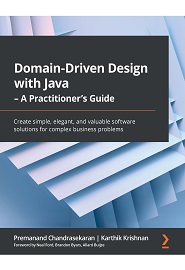
English | 2022 | ISBN: 978-1800560734 | 302 Pages | PDF, EPUB | 51 MB
Adopt a practical and modern approach to architecting and implementing DDD-inspired solutions to transform abstract business ideas into working software across the entire spectrum of the software development life cycle
Key Features
- Implement DDD principles to build simple, effective, and well-factored solutions
- Use lightweight modeling techniques to arrive at a common collective understanding of the problem domain
- Decompose monolithic applications into loosely coupled, distributed components using modern design patterns
Domain-Driven Design (DDD) makes available a set of techniques and patterns that enable domain experts, architects, and developers to work together to decompose complex business problems into a set of well-factored, collaborating, and loosely coupled subsystems.
This practical guide will help you as a developer and architect to put your knowledge to work in order to create elegant software designs that are enjoyable to work with and easy to reason about. You’ll begin with an introduction to the concepts of domain-driven design and discover various ways to apply them in real-world scenarios. You’ll also appreciate how DDD is extremely relevant when creating cloud native solutions that employ modern techniques such as event-driven microservices and fine-grained architectures. As you advance through the chapters, you’ll get acquainted with core DDD’s strategic design concepts such as the ubiquitous language, context maps, bounded contexts, and tactical design elements like aggregates and domain models and events. You’ll understand how to apply modern, lightweight modeling techniques such as business value canvas, Wardley mapping, domain storytelling, and event storming, while also learning how to test-drive the system to create solutions that exhibit high degrees of internal quality.
By the end of this software design book, you’ll be able to architect, design, and implement robust, resilient, and performant distributed software solutions.
What you will learn
- Discover how to develop a shared understanding of the problem domain
- Establish a clear demarcation between core and peripheral systems
- Identify how to evolve and decompose complex systems into well-factored components
- Apply elaboration techniques like domain storytelling and event storming
- Implement EDA, CQRS, event sourcing, and much more
- Design an ecosystem of cohesive, loosely coupled, and distributed microservices
- Test-drive the implementation of an event-driven system in Java
- Grasp how non-functional requirements influence bounded context decompositions
Resolve the captcha to access the links!